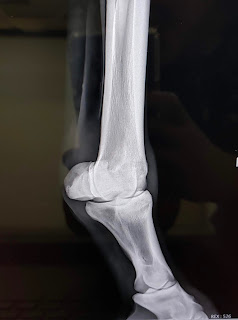We lost power this week and it was all hands on deck as we worked to get water to the horses not only in the hospital, but out in the fields as well. There was a crazy ~10 minute storm with high winds that caused many towns in NJ to lose power. Other than a limited supply through generator, our power was out from Monday night to Thursday afternoon— but that didn’t stop us from seeing appointments!
We saw an epiglottic entrapment in which the aryepiglottic fold (a normal part of larynx anatomy) envelops the epiglottis, potentially leading to poor racing performance. The entrapment is diagnosed by endoscope and in this case the aryepiglottic fold was transected to free the epiglottis.
Case Highlight: EOTRH
Equine Odontoclastic Tooth Resorption and Hypercementosis (EOTRH) is a syndrome most commonly seen in older horses that results in resorptive lesions of the incisors and canine teeth. EOTRH is typically diagnosed through radiographs but the pathophysiology of the disease is currently unknown. The only current treatment that exists is to extract the affected teeth.
Affected teeth are extracted due to tooth loosening and associated pain. Loose teeth can fracture off as in the case of this patient. Many horses actually do much better once the teeth have been extracted as they can go back to eating/being horses without feeling pain.
Thank you to everyone who read these posts and followed along during my time at New Jersey Equine Clinic!
A special thank you to the nurse staff at NJEC - Melissa, Alisha, and Danielle for letting us get in their way and sometimes take over, Dr. Leahy for her Spartan camaraderie and life lessons and lastly Dr. Smith for being ever so willing to answer questions and keep us on our toes while dishing out questions. I am so truly thankful for the experience and am forever grateful to have been taken in having had mostly small animal experience. Thank you for remembering what it was like to be a student and for giving me a chance in equine med. I can’t wait to share all of my acquired knowledge!
Lastly, a million thank you's to Dr. Rashmir and Dr. Schott of MSU who without their support this invaluable experience would have never happened.
Lastly, a million thank you's to Dr. Rashmir and Dr. Schott of MSU who without their support this invaluable experience would have never happened.
Happy Summer Everyone! Off to our next adventure!
Stefany Gomez
MSU CVM 2021






















